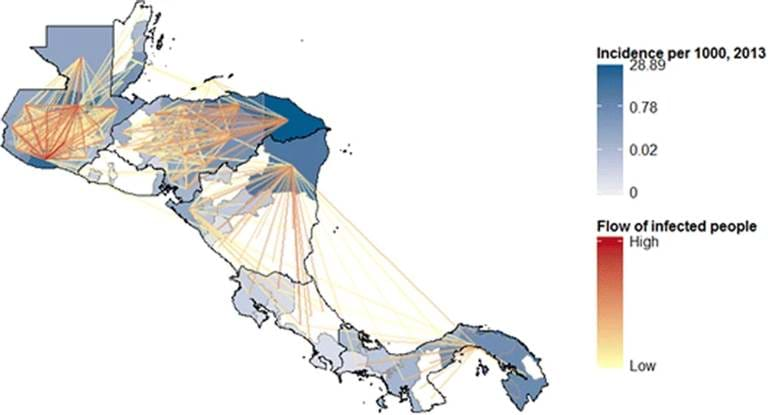Nick W Ruktanonchai, Darlene Bhavnani, Alessandro Sorichetta, Linus Bengtsson, Keith H Carter, Roberto C Córdoba, Arnaud Le Menach, Xin Lu, Erik Wetter, Elisabeth zu Erbach-Schoenberg, and Andrew J Tatem.
Numerous countries around the world are approaching malaria elimination. Until global eradication is achieved, countries that successfully eliminate the disease will contend with parasite reintroduction through international movement of infected people. Human-mediated parasite mobility is also important within countries near elimination, as it drives parasite flows that affect disease transmission on a subnational scale.
Abstract
Movement patterns exhibited in census-based migration data are compared with patterns exhibited in a mobile phone data set from Haiti to quantify how well migration data predict short-term movement patterns. Because short-term movement data were unavailable for Mesoamerica, a logistic regression model fit to migration data from three countries in Mesoamerica is used to predict flows of infected people between subnational administrative units throughout the region.
Population flows predicted using census-based migration data correlated strongly with mobile phone-derived movements when used as a measure of relative connectivity. Relative population flows are therefore predicted using census data across Mesoamerica, informing the areas that are likely exporters and importers of infected people. Relative population flows are used to identify community structure, useful for coordinating interventions and elimination efforts to minimize importation risk. Finally, the ability of census microdata inform future intervention planning is discussed in a country-specific setting using Costa Rica as an example.
These results show long-term migration data can effectively predict the relative flows of infected people to direct malaria elimination policy, a particularly relevant result because migration data are generally easier to obtain than short-term movement data such as mobile phone records. Further, predicted relative flows highlight policy-relevant population dynamics, such as major exporters across the region, and Nicaragua and Costa Rica’s strong connection by movement of infected people, suggesting close coordination of their elimination efforts. Country-specific applications are discussed as well, such as predicting areas at relatively high risk of importation, which could inform surveillance and treatment strategies.

Predicted flows of infected people (red). These estimates are created using population flow estimates and scaled using incidence from 2013 in the origin location (blue).